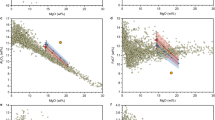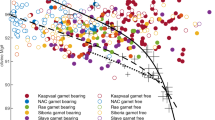Abstract
There is uncertainty about whether the abundant tholeiitic lavas on Hawaii are the product of melt from peridotite or pyroxenite/eclogite rocks1,2. Using a parameterization of melting experiments on peridotite3 with glass analyses from the Hawaii Scientific Deep Project 2 on Mauna Kea volcano1, I show here that a small population of the core samples had fractionated from a peridotite-source primary magma. Most lavas, however, differentiated from magmas that were too deficient in CaO and enriched in NiO (ref. 2) to have formed from a peridotite source. For these, experiments indicate that they were produced by the melting of garnet pyroxenite, a lithology that had formed in a second stage by reaction of peridotite with partial melts of subducted oceanic crust2. Samples in the Hawaiian core are therefore consistent with previous suggestions that pyroxenite occurs in a host peridotite, and both contribute to melt production2,4. Primary magma compositions vary down the drill core, and these reveal evidence for temperature variations within the underlying mantle plume. Mauna Kea magmatism is represented in other Hawaiian volcanoes, and provides a key for a general understanding of melt production in lithologically heterogeneous mantle.
This is a preview of subscription content, access via your institution
Access options
Subscribe to this journal
Receive 51 print issues and online access
$199.00 per year
only $3.90 per issue
Buy this article
- Purchase on Springer Link
- Instant access to full article PDF
Prices may be subject to local taxes which are calculated during checkout




Similar content being viewed by others
References
Stolper, E., Sherman, S., Garcia, M., Baker, M. & Seaman, C. Glass in the submarine section of the HSDP2 drill core, Hilo, Hawaii. Geochem. Geophys. Geosyst. 5 doi: 10.1029/2003GC000553 (2004)
Sobolev, A. V., Hofmann, A. W., Sobolev, S. V. & Nikogosian, I. K. An olivine-free mantle source of Hawaiian shield basalts. Nature 434, 590–597 (2005)
Walter, M. J. Melting of garnet peridotite and the origin of komatiite and depleted lithosphere. J. Petrol. 39, 29–60 (1998)
Ren, Z-Y., Ingle, S., Takahashi, E., Hirano, N. & Hirata, T. The chemical structure of the Hawaiian plume. Nature 436, 837–840 (2005)
Rhodes, J. M. & Vollinger, M. J. Composition of basaltic lavas sampled by phase-2 of the Hawaii Scientific Drilling Project: geochemical stratigraphy and magma types. Geochem. Geophys. Geosyst. 5 doi: 10.1029/2002GC000434 (2004)
Frey, F. A. et al. The evolution of Mauna Kea volcano, Hawaii: petrogenesis of tholeiitic and alkalic basalts. J. Geophys. Res. B 96, 14347–14375 (1991)
Sobolev, A. V. & Nikogosian, I. K. Petrology of long-lived mantle plume magmatism: Hawaii, Pacific, and Reunion islands, Indian Ocean. Petrology 2, 111–144 (1994)
Herzberg, C. & O’Hara, M. J. Plume-associated ultramafic magmas of Phanerozoic age. J. Petrol. 43, 1857–1883 (2002)
Arndt, N. T., Kerr, A. C. & Tarney, J. Dynamic melting in plume heads: the formation of Gorgona komatiites and basalts. Earth Planet. Sci. Lett. 146, 289–301 (1997)
O’Hara, M. J. & Yoder, H. S. Jr. Formation and fractionation of basic magmas at high pressures. Scott. J. Geol. 3, 67–117 (1967)
Milholland, C. S. & Presnall, D. C. Liquidus phase relations in the CaO-MgO-Al2O3-SiO2 system at 3.0 GPa: The aluminous pyroxene thermal divide and high pressure fractionation of picritic and komatiitic magmas. J. Petrol. 39, 3–27 (1998)
Kogiso, T., Hirschmann, M. M. & Pertermann, M. High-pressure partial melting of mafic lithologies in the mantle. J. Petrol. 45, 2407–2422 (2004)
Pertermann, M. & Hirschmann, M. M. Anhydrous partial melting experiments on MORB-like eclogite: phase relations, phase compositions and mineral-melt partitioning of major elements at 2–3 GPa. J. Petrol. 44, 2173–2201 (2003)
Yaxley, G. M. & Green, D. H. Reactions between eclogite and peridotite: mantle refertilisation by subduction of oceanic crust. Schweiz. Mineral. Petrogr. Mitt. 78, 243–255 (1998)
Sobolev, A. V., Hofmann, A. W. & Nikogosian, I. K. Recycled oceanic crust observed in ‘ghost plagioclase’ within the source of Mauna Loa lavas. Nature 404, 986–989 (2000)
Ito, K. & Kennedy, G. C. Melting and phase relations in the plane tholeiite-lherzolite-nepheline basanite to 40 kilobars and geological implications. Contrib. Mineral. Petrol. 19, 177–211 (1968)
Maaloe, S. The PT-phase relations of an MgO-rich Hawaiian tholeiite: the compositions of primary Hawaiian tholeiites. Contrib. Mineral. Petrol. 148, 236–246 (2004)
Hirschmann, M. M. Mantle solidus: experimental constraints and the effects of peridotite composition. Geochem. Geophys. Geosyst. 1 doi: 10.1029/2000GC000070 (2000)
Herzberg, C., Ratteron, P. & Zhang, J. New experimental observations on the anhydrous solidus for peridotite KLB-1. Geochem. Geophys. Geosyst. 1 doi: 10.1029/2000GC000089 (2000)
Takahashi, E. & Nakajima, K. in Hawaiian Volcanoes: Deep Underwater Perspectives (eds Takahashi, E., Lipman, P. W., Garcian, M. O., Naka, J. & Aramaki, S.) Vol. 128 403–418 (Geophys. Monogr. Ser., AGU, Washington DC, 2002)
Korzhinskii, D. S. Theory of Metasomatic Zoning (Clarendon, Oxford, 1970)
Kogiso, T., Hirschmann, M. M. & Reiners, P. W. Length scales of mantle heterogeneities and their relationship to ocean island basalt geochemistry. Geochim. Cosmochim. Acta 68, 345–360 (2004)
Abouchami, W. et al. Lead isotopes reveal bilateral asymmetry and vertical continuity in the Hawaiian mantle plume. Nature 434, 851–856 (2005)
Blichert-Toft, J., Weis, D., Maerschalk, C., Agranier, A. & Albarède, F. Hawaiian hot spot dynamics as inferred from the Hf and Pb isotope evolution of Mauna Kea volcano. Geochem. Geophys. Geosyst. 4 doi: 10.1029/2002GC000340 (2003)
Lassiter, J. C. & Hauri, E. H. Osmium-isotope variations in Hawaiian lavas: evidence for recycled lithosphere in the Hawaiian plume. Earth Planet. Sci. Lett. 164, 483–496 (1998)
Blichert-Toft, J., Frey, F. A. & Albarède, F. Hf isotope evidence for pelagic sediments in the source of Hawaiian basalts. Science 285, 879–882 (1999)
Huang, S. et al. Enriched components in the Hawaiian plume: Evidence from Kahoolawe volcano, Hawaii. Geochem. Geophys. Geosyst. 6 doi: 10.1029/2005GC001012 (2005)
Hauri, E. Major element variability in the Hawaiian plume. Nature 382, 415–419 (1996)
Toplis, M. J. The thermodynamics of iron and magnesium partitioning between olivine and liquid: criteria for assessing and predicting equilibrium in natural and experimental systems. Contrib. Mineral. Petrol. 149, 22–39 (2005)
Beattie, P. Olivine-melt and orthopyroxene-melt equilibria. Contrib. Mineral. Petrol. 115, 103–111 (1993)
Acknowledgements
I am grateful to A. Sobolev, M. Feigenson, M. Hirschmann, F. Frey and P. Asimow for discussions. I also thank A. Hofmann and A. Sobolev for critical comments.
Author information
Authors and Affiliations
Corresponding author
Ethics declarations
Competing interests
Reprints and permissions information is available at www.nature.com/reprints. The authors declare no competing financial interests.
Supplementary information
Supplementary Notes
This file provides a detailed explanation of peridotite and pyroxenite modelling. (DOC 55 kb)
Supplementary Table 1
Compositions of liquids at the pseudoinvariant points in Figures S4-S6 (wt%) as simple CMAS “equivalents” of naturally-occurring lava compositions (DOC 22 kb)
Supplementary Figure Legends
This file contains text to accompany the below Supplementary Figures. (DOC 29 kb)
Supplementary Figure 1
Experimental data of Walter1 showing the CaO content of liquids as a function of melt fraction of fertile mantle peridotite KR-4003. (EPS 1125 kb)
Supplementary Figure 2
Experimental data of Walter1 showing howing the CaO and MgO contents of liquids in fertile mantle peridotite KR-4003. (EPS 1150 kb)
Supplementary Figure 3
Computed CaO and MgO contents of accumulated fractional melts of fertile peridotite. (EPS 1169 kb)
Supplementary Figure 4
Projections of experimental compositions at 2.5 and 3 GPa for which the liquidus phase has been determined, or the compositions of liquids determined by electron microprobe in equilibrium with specific liquidus phases shown. (EPS 1261 kb)
Supplementary Figure 5
Projections similar to Figure S4, but with experimental data of Pertermann and Hirschmann25 on silicic MORB-like eclogite at 3 GPa. (EPS 755 kb)
Supplementary Figure 6
Projections similar to those depicted in Figure S4, but for experimental data at 4 GPa. (EPS 1171 kb)
Supplementary Figure 7
A summary of experimental brackets in Figures S4-S6 at 3 and 4 GPa. (EPS 1176 kb)
Supplementary Figure 8
A projection from olivine into the plane Anorthite-Diopside-Enstatite30 of model pyroxenite primary magmas derived from HSDP2 glasses with MgO > 7.5% and whole rocks. (EPS 1238 kb)
Supplementary Figure 9
Projections of cotectic equilibria at 3 GPa from Figure S5 and basaltic crust used in the experiments of Pertermann and Hirschmann. (EPS 795 kb)
Rights and permissions
About this article
Cite this article
Herzberg, C. Petrology and thermal structure of the Hawaiian plume from Mauna Kea volcano. Nature 444, 605–609 (2006). https://doi.org/10.1038/nature05254
Received:
Accepted:
Published:
Issue Date:
DOI: https://doi.org/10.1038/nature05254
This article is cited by
-
Deep recycling of crustal materials by the Hainan mantle plume: evidence from Zn–Sr–Nd–Pb isotopes of Hainan Island basalts
Contributions to Mineralogy and Petrology (2024)
-
Genesis of Hawaiian lavas by crystallization of picritic magma in the deep mantle
Nature Communications (2023)
-
Olivine and melt inclusion chemical constraints on the nature and origin of the common mantle component beneath eastern Asia
Contributions to Mineralogy and Petrology (2022)
-
Old subcontinental mantle zircon below Oahu
Communications Earth & Environment (2021)
-
Source and magmatic evolution of ocean island basalts from the Pohnpei Island, Northwest Pacific Ocean: Insights from olivine geochemistry
Acta Oceanologica Sinica (2021)
Comments
By submitting a comment you agree to abide by our Terms and Community Guidelines. If you find something abusive or that does not comply with our terms or guidelines please flag it as inappropriate.



